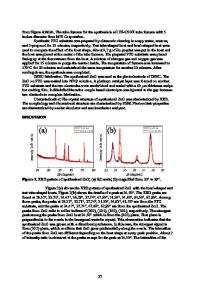Morphological evolution of large-scale vertically aligned ZnO nanowires and their photoluminescence properties by hydrog
- PDF / 765,673 Bytes
- 6 Pages / 612 x 792 pts (letter) Page_size
- 36 Downloads / 321 Views
Morphological evolution of large-scale vertically aligned ZnO nanowires and their photoluminescence properties by hydrogen plasma treatment Miao Zhong, Yanbo Li, Alexander Paulsen, Takero Tokizono, Ichiro Yamada, and Jean-Jacques Delaunay Department of Mechanical Engineering, The University of Tokyo, 7-3-1 Hongo, Bunkyo-ku, Tokyo 113-8656, Japan ABSTRACT In this report, large-scale vertically aligned ZnO nanowires, with diameter around 75 nm and length around 2-5 μm, were synthesized on a-plane sapphire by a single step chemical vapor deposition method. The XRD pattern of the as-prepared sample showed a strong ZnO (0002) peak and a weak ZnO (0004) peak that indicate good orientation and high crystal quality of the ZnO nanowires. The sample was then treated by hydrogen plasma, without exhibiting obvious structural damage to the nanowires. The photoluminescence spectra of as-prepared and H2plasma-treated samples were then examined. A strong green emission peak (centered at 520 nm) was observed in the PL spectrum of as-prepared sample. In sharp contrast, a significant increase of the near-band edge emission (centered at 380 nm) and a strong decrease of the green emission (centered at 520 nm) were found in the PL spectrum of H2-plasma-treated sample. We propose that an efficient passivation of oxygen vacancies by H atoms will cause a drastic decrease of the green emission. More important, it would lead to a significant reduction of surface depletion layer, leading to a great enlargement of total effect area for UV emission. Meanwhile, the significant enhancement of the intensity of UV emission might also attribute to the combined effects of structure-induced waveguide behavior and UV amplified spontaneous emission. It is expected that the enhanced UV emission of vertically aligned ZnO nanowires can be used to improve the performance of UV light emitting devices. INTRODUCTION Zinc oxide (ZnO), with its unique properties such as wide band gap, large exciton binding energy (60 meV) and excellent luminescent properties, trigger great interest for the development of its photonic devices, such as ultraviolet light emitting diodes and laser diodes [1]. Comparing to the bulk and thin-film counterparts, nanoscale devices, assembled on well-aligned freestanding nanowire (NW) arrays, could enable new functions, high efficiency, and enhanced performance [2]. Therefore, various techniques, including metal-organic chemical vapor deposition, vapor phase epitaxy, pulsed laser deposition, and aqueous chemical growth are used for growth of functional ZnO NWs. In this report, large scale vertically aligned ZnO NWs were synthesized on a-plane sapphire via a simple chemical vapor deposition (CVD) method. The growth mechanism is proposed for a better understanding of evolutional process of vertically aligned ZnO NWs and for a better growth control of future synthesis. The as-prepared sample was treated by hydrogen plasma at room temperature for 1 min in a reactive ion etching (RIE) system. Photoluminescence
(PL) properties of ZnO NWs befor
Data Loading...









